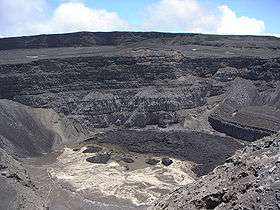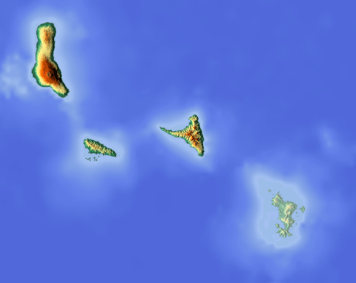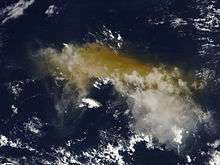Mount Karthala
| Mount Karthala | |
|---|---|
 Karthala volcano crater in November 2006 | |
| Highest point | |
| Elevation | 2,361 m (7,746 ft) [1] |
| Prominence | 2,361 m (7,746 ft) [1] |
| Listing |
Ultra Country high point |
| Coordinates | 11°45′24″S 43°21′42″E / 11.75667°S 43.36167°ECoordinates: 11°45′24″S 43°21′42″E / 11.75667°S 43.36167°E [1] |
| Geography | |
 Mount Karthala | |
| Geology | |
| Mountain type | Shield volcano (active) |
| Last eruption | January 2007 |
| Official name | Le Karthala |
| Designated | 12 November 2006 |
| Reference no. | 1649[2] |
Mount Karthala or Karthola (Arabic: القرطالة Al Qirtālah) is an active volcano and the highest point of the Comoros at 2,361 m (7,746 ft) above sea level. It is the southernmost and larger of the two shield volcanoes forming Grande Comore island, the largest island in the nation of Comoros. The Karthala volcano is very active, having erupted more than 20 times since the 19th century. Frequent eruptions have shaped the volcano’s 3 km by 4 km summit caldera, but the island has largely escaped broad destruction. Eruptions on April 17, 2005 and May 29, 2006 ended a period of quiet.
April 2005 eruption

The eruption, which carried a risk of lava flows and deadly volcanic gas, caused the evacuation of 30,000 residents.
The crater was clearly changed by the April 2005 eruption. A grey field of ash surrounds the crater and the caldera itself seems larger and deeper. The crater lake, which formed after Karthala's last eruption in 1991 and once dominated the caldera, is now gone completely. In its place were rough, dark grey rocks, possibly cooling lava or rubble from the collapsed crater.
May 2006 activity
On May 29, Reuters reported that residents of Moroni could see lava at the top of the volcano.[3] Within a few days the volcanic activity subsided.[4]
Flora and fauna
The mountain is covered by moist evergreen forest up to about 1800 metres above sea-level. Higher up the vegetation consists of stunted trees and heathland where the giant heather Erica comorensis grows.
Many of the species found on the mountain are unique to the Comoros and four bird species are found only on the slopes of Mount Karthala: Humblot's flycatcher, Comoro white-eye, Comoro drongo and Karthala scops owl.
The mountain's forest is threatened by logging and the spread of agriculture. A nature reserve has been proposed to cover the mountain; it has not yet been created.
References
- 1 2 3 Listed as "Le Kartala" on Peaklist.org Retrieved 27 September 2011
- ↑ "Le Karthala". Ramsar Sites Information Service. Retrieved 25 April 2018.
- ↑ "Archived copy". Archived from the original on 2009-10-04. Retrieved 2006-05-29.
- ↑
- "Karthala". Global Volcanism Program. Smithsonian Institution.
- "Karthala – Monthly Reports". Global Volcanism Program. Smithsonian Institution.
- "Comoros forests". Terrestrial Ecoregions. World Wildlife Fund. Downloaded 27/02/07.
See also